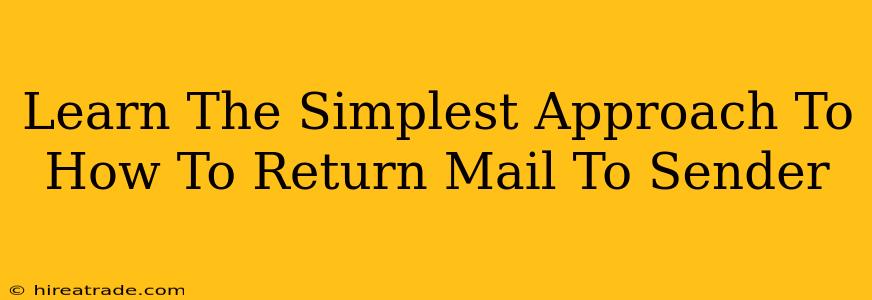Returning mail to sender might seem daunting, but it's actually a straightforward process. This guide breaks down the simplest ways to handle unwanted mail, whether it's a single letter or a stack of junk mail. We'll cover everything from the right markings to the best delivery method, ensuring your returned mail arrives safely and efficiently at its intended destination.
Understanding Why You Might Need To Return Mail
Before we dive into the how, let's quickly cover the why. There are several reasons you might find yourself needing to return mail to the sender:
- Incorrect Address: The most common reason. The mail is addressed to someone who doesn't live at your address, or the address is simply incorrect.
- Forwarding Issues: Sometimes, even with forwarding set up, mail can end up at your old address.
- Unwanted Mail: Junk mail, solicitations, or anything else you don't want cluttering your mailbox.
- Deceased Recipient: If mail arrives for someone who is deceased, returning it prevents further unnecessary correspondence.
The Simplest Method: Writing "Return to Sender"
This is the most basic and often sufficient method. Simply write "Return to Sender" clearly and legibly on the front of the envelope. This instruction is generally understood by postal services worldwide.
Enhancing Your "Return to Sender" Marking:
For better results, consider these additions:
- Add a Cross-out: Cross out the original address with a pen or marker.
- Your Return Address (Optional but Recommended): While not strictly required, adding your return address helps ensure the postal service can contact you if there are any issues.
Beyond "Return to Sender": More Detailed Instructions
If the "Return to Sender" method isn't working, or you need more specific instructions, try these alternatives:
- "Unable to Forward" Stamp: Some post offices offer a special stamp that clearly indicates the recipient couldn't be reached. This is more formal than simply writing it by hand.
- Specific Reason: Briefly explain why you're returning the mail. For example, "Incorrect Address," "Moved," or "Deceased."
How to Actually Return the Mail
Once you've marked the envelope appropriately, simply:
- Replace the original stamp: If the stamp is damaged from your markings, make sure to place a new stamp on the envelope.
- Deposit it in a mailbox: You can return the mail using any standard mailbox.
Dealing with Large Quantities of Unwanted Mail
If you consistently receive large volumes of junk mail, here are some additional strategies:
- Contact the Sender Directly: Many companies have addresses or online methods for unsubscribing from their mailing lists.
- USPS Informed Delivery: This free service from the USPS lets you preview your mail digitally before it arrives, allowing you to identify and possibly intercept unwanted mail before it even reaches your mailbox.
- Opt Out of Mailing Lists: Websites like DMAchoice offer a centralized way to opt out of receiving marketing mail from various companies.
Returning mail to sender doesn't have to be complicated. By following these simple steps, you can efficiently handle unwanted or misdirected mail and keep your mailbox clutter-free. Remember, clear and concise markings are key!

